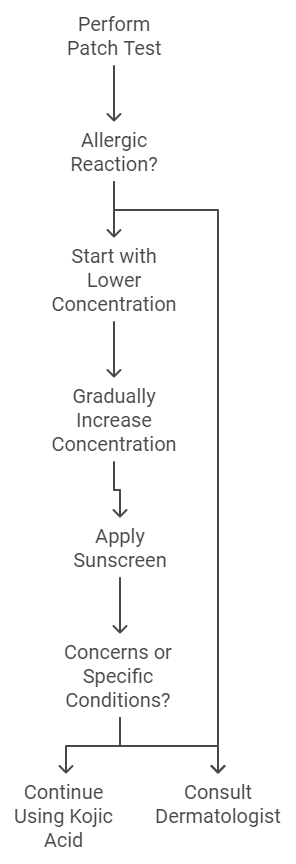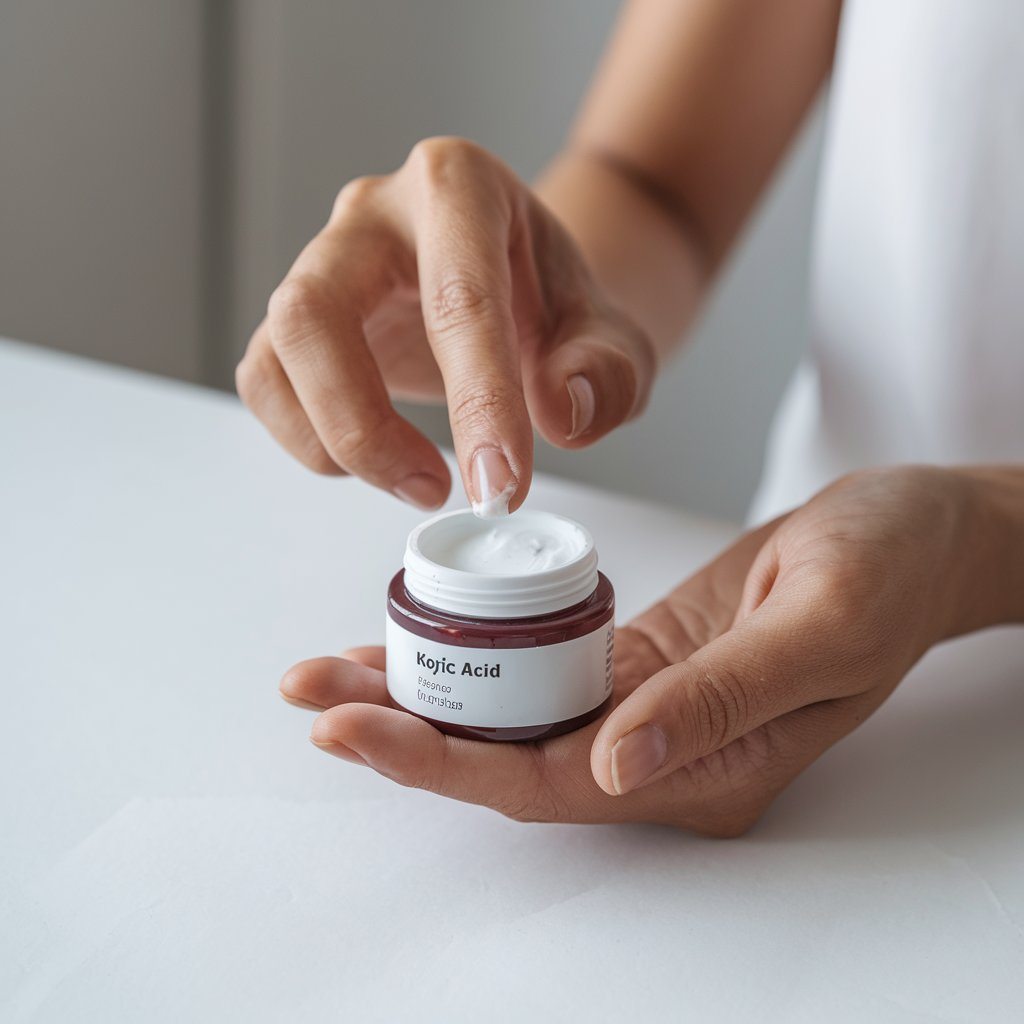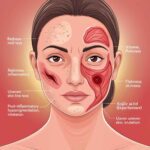- Patch testing helps prevent adverse reactions
- Starting with a 1-2% concentration is best for beginners
- It’s better to use kojic acid at night
- Moisturize after applying kojic acid
Over the years, research has demonstrated kojic acid’s effectiveness in addressing hyperpigmentation issues. It achieves this by inhibiting tyrosinase, an enzyme that plays a central role in the production of melanin.
Despite its effectiveness, you need to use kojic acid with care, as it can increase skin sensitivity, particularly to the sun. This guide provides a comprehensive approach to safely and effectively incorporating kojic acid into your skincare routine.

Always Do a Patch Test Before Using New Products
Kojic acid, like any active ingredient, has the potential to cause irritation, especially in people with sensitive skin. A patch test involves applying a small amount of the product to a small area, like the forearm, and waiting 24-48 hours to check for reactions. Signs of irritation could include redness, itching, or swelling. If no such reactions occur, it’s likely safe to apply the product to your face.
Choose a Product with 1-2% Concentration for Beginners
Kojic acid is available in different formulations—creams, serums, soaps, and powders. If you’re new to kojic acid, it’s important to start with a product that contains a lower concentration, ideally between 1-2%. Starting with this concentration allows your skin to adjust to the ingredient gradually.
Higher concentrations can be too harsh, especially for sensitive skin, potentially causing irritation or dryness. You can also find products that combine kojic acid with other beneficial ingredients, such as vitamin C or niacinamide. Always check the product’s ingredient list and instructions to ensure you’re using the right concentration for your skin type.
Everything you Should Know About Kojic Acid in Skincare
Use a Gentle Cleanser Before Applying Kojic Acid
A cleanser helps to remove dirt, oil, and makeup without disrupting your skin’s natural moisture barrier. It’s important to avoid harsh or stripping cleansers, as these can dry out your skin and make it more vulnerable to irritation from the kojic acid.
The goal is to create a clean, smooth canvas so that the kojic acid can absorb effectively and work its magic. Make sure your skin is dry before applying kojic acid, as damp skin can sometimes amplify the potency of active ingredients, leading to irritation.
Apply Kojic Acid as a Spot Treatment
Kojic acid can be applied all over your face. But if your primary concern is targeting specific dark spots, you may get better results using it as a spot treatment. This allows you to concentrate the ingredient on problem areas where pigmentation is more pronounced.
To apply it as a spot treatment, simply dab a small amount of your kojic acid serum or cream directly onto the affected areas. This method helps you treat the dark spots more effectively without exposing your entire face to the ingredient.
Timing Matters: Day or Night Use?
Kojic acid can be used either in the morning or evening, but many experts recommend incorporating it into your nighttime routine. This is because kojic acid increases your skin’s sensitivity to the sun, leading to sunburn or worsening pigmentation issues. If you choose to use it during the day, follow up with a broad-spectrum sunscreen to protect your skin.
At night, your skin has time to repair and absorb the active ingredients without exposure to UV rays, making this an ideal time to apply kojic acid. Whether you choose day or night, consistency is key for seeing the benefits.
Always Moisturize Well
Kojic acid can be drying, particularly for people with sensitive or dry skin. while it’s working to reduce pigmentation, it may also disrupt your skin’s moisture balance. After applying kojic acid, follow up with a moisturizer to replenish hydration and support your skin’s barrier.
Look for moisturizers that contain soothing ingredients like hyaluronic acid, glycerin, or ceramides, which help to lock in moisture . A well-moisturized skin barrier will not only feel more comfortable but will also allow the kojic acid to work more effectively.
Follow Up with Sunscreen
Because kojic acid inhibits melanin production, it can leave your skin more vulnerable to UV damage. This is why applying sunscreen every morning is a non-negotiable step in your skincare routine if you’re using kojic acid. Even on cloudy days or when you’re staying indoors, the UV rays that penetrate windows can still harm your skin. A broad-spectrum sunscreen with at least SPF 30 is recommended.
Monitor Your Skin’s Reactions
Every skin type is different, and kojic acid might affect you differently than others. It’s essential to monitor your skin’s response after introducing kojic acid into your routine. If you notice signs of irritation, such as redness, dryness, or stinging, it may be best to reduce the frequency of use.
For some people, using kojic acid every other day instead of daily can still provide benefits without overwhelming the skin. If your skin shows no signs of irritation, you can gradually increase usage, but it’s crucial to always listen to your skin. Overuse can lead to irritation, counteracting the benefits of kojic acid.
Consistency Is Key for Visible Results
Kojic acid isn’t a quick fix, and it takes time to see results. On average, you may start to notice improvements in your skin tone and reduced hyperpigmentation after several weeks of consistent use. stick to your skincare routine, as using kojic acid sporadically won’t deliver the desired results.
Patience and consistency are crucial, so don’t be discouraged if changes aren’t immediate. Over time, regular use of kojic acid will lead to clearer, more even-toned skin, but only if you commit to applying it regularly and taking care of your skin with the necessary precautions.
Consult a Dermatologist If Needed
If you have persistent skin concerns or are unsure about using kojic acid, it’s always a good idea to consult a dermatologist. Dermatologists can provide personalized advice based on your skin type and concerns. For hyperpigmentation or skin conditions like melasma, a professional opinion can help ensure you’re using kojic acid safely. Dermatologists can also recommend additional treatments that may complement kojic acid and enhance your results.
Precautions When Using Kojic Acid
While kojic acid is generally safe, there are certain precautions you should take:
-
Avoid applying it to broken or inflamed skin.
-
Start with a low concentration, especially if you have sensitive skin.
-
Discontinue use if you experience severe irritation.
-
Ensure diligent use of sunscreen during and after kojic acid application.
Potential Side Effects
While kojic acid is safe for most skin types, some people may experience side effects. These include:
-
Redness: This could be a sign of irritation, especially for sensitive skin types.
-
Dryness: Kojic acid may deplete moisture levels, leading to flaky skin.
-
Photosensitivity: Increased sun sensitivity is common, which is why sunscreen is essential.
If you notice any severe side effects, discontinue use immediately.
Combining Kojic Acid with Other Ingredients
When incorporating kojic acid into your skincare routine, you might wonder if it’s safe to combine with other active ingredients. Here’s a quick guide:
-
Vitamin C: A powerful antioxidant that enhances skin brightening effects. These two ingredients work well together to fade dark spots faster.
-
Niacinamide: Known for its anti-inflammatory properties, niacinamide complements kojic acid by reducing irritation and calming the skin.
-
AHA/BHA: While kojic acid itself has mild exfoliating properties, combining it with AHA (like glycolic acid) or BHA (like salicylic acid) could be too harsh for sensitive skin. If you’re using both, alternate them on different days to avoid irritation.
Final Thoughts on Kojic Acid
Incorporating kojic acid into your skincare routine may help brighten your complexion and fade hyperpigmentation. While it’s generally safe and effective, always listen to your skin and adjust usage as needed. With proper precautions and consistent application, kojic acid can be your go-to ingredient for a radiant, even skin tone.
Sources:
https://www.healthline.com/health/kojic-acid
https://www.bostondermadvocate.com/science-of-skincare/kojic-acid-ultimate-dermatologist-guide

I’m a devoted organic skincare enthusiast, passionate about the natural, wholesome goodness that organic products bring to our skin.
Organic skincare isn’t just a hobby for me—it’s a lifestyle. Every product I use, recommend, and write about has been carefully chosen for its purity and effectiveness. Everything I write about is backed by scientific studies, dermatologists’ opinions, and user experiences.
I also excel at tackling skincare challenges with innovative, organic solutions.


